2016 年 85 巻 1 号 p. 30-36
2016 年 85 巻 1 号 p. 30-36
We investigated the effect of soil surface management on radiocesium accumulation in an apple orchard in Fukushima Prefecture over 4 years after Tokyo Electric Power Company’s Fukushima Daiichi nuclear power plant accident in mid-March 2011. Different types of soil surface management such as clean cultivation, intertillage management, intertillage with bark compost application, sod culture, and zeolite application were employed. The radiocesium concentrations in soil were higher in the surface layer (0–5 cm) than in the other layers. The radiocesium concentration in the surface layer soil with sod culture in 2014 increased non-significantly compared with that observed in 2011. The radiocesium concentration in the mid-layer soil (5–15 cm) managed with intertillage was higher than that in soil managed using other types of management. The radiocesium amount in the organic matter on the soil surface was the highest in sod culture, and was significantly lower in the management with intertillage. The radiocesium concentration in fruit decreased exponentially during the 4 years in each types of soil surface management. The decrease in radiocesium concentration showed similar trends with each type of soil surface management, even if the concentration in each soil layer varied according to the management applied. Furthermore, intertillage with bark compost application did not affect the radiocesium concentration in fruit. These results suggest that the soil surface management type that affected the radiocesium distribution in the soil or the compost application with conventional practice did not affect its concentration in fruit of apple trees for at least 4 years since the nuclear power plant accident, at a radiocesium deposition level similar to that recorded in Fukushima City.
After Tokyo Electric Power Company’s Fukushima Daiichi nuclear power plant (FDNPP) accident in mid-March 2011, radionuclides were widely distributed across a large area. Consequently, many fruit orchards in the vicinity were also contaminated, mainly by radiocesium. At the time of the accident, many kinds of deciduous fruit trees, including apple trees, had not yet sprouted; thus, diffused radiocesium fell onto the trunks and branches of these trees, as well as on the soil surface in these orchards.
Arapis et al. (1997) reported that the migration rate of 137Cs in soil ranged from 0.39 to 1.16 cm/year, with the majority of residual radiocesium located in the upper layer (10 cm) of soil even 7 years after the Chernobyl accident. Similar observations were made for trees in fruit orchards three years after the FDNPP accident in Fukushima (Sato, 2014). Antonopoulos-Domis et al. (1991) demonstrated that the root uptake of radiocesium represented a small fraction of the total contamination of leaves and fruit of trees planted before the Chernobyl accident. Sato et al. (2015) also suggested that the amount of radiocesium uptake via the roots of fruit trees was negligible after the FDNPP accident. On the other hand, Takata et al. (2013) reported that, with a high concentration of radiocesium in the surface soil, the transfer rate of radiocesium from the soil to plants was higher in the shallow-rooted fruit tree fig than in the non-shallow-rooted fruit tree grape, suggesting that the radiocesium uptake via the roots of fruit trees could not be negligible under experimental conditions.
In Japan, the soil surface of many fruit orchards is managed by either herbicide treatment or sod culture. In the sod culture of fruit trees, the soil surface is either covered with cover crops or weeds. Therefore, many radiocesium elements could not fall directly onto the soil surface. On the other hand, organic matter, mainly compost, is often used to improve the physical properties of soil in orchards. Mixing of the surface soil and compost is more effective than direct surface application of organic matter for the improvement of soil physical properties. In such cases, the radiocesium accumulated in the surface soil could be plowed into the lower layers of soil. Unlike in fruit tree cultivation, intertillage of the plow layer soil is necessary for the cultivation of annual field crops such as vegetables. It is essential to understand the differences in the effects of intertillage on the accumulation of radiocesium in the edible parts of annual field crops and fruit trees.
In order to prevent the absorption of radiocesium by plant roots, zeolite materials were widely used for the adsorption of radiocesium that fell onto the fields in radionuclide-contaminated areas affected by the FDNPP accident. These materials can effectively adsorb radiocesium (Collins et al., 1984). However, the effects of zeolite application to soil in fruit orchards on the radiocesium concentration of the trees remain unclear.
In this study, we investigated the radiocesium concentrations in the soil of an apple orchard, organic matter on the soil surface under a canopy, and apple fruit in the orchard. The aim of this study was to clarify the effect of soil surface management on the radiocesium concentration in apple fruit.
Samples of apple fruit, soil, and organic matter on the soil surface under the canopy were collected in an experimental field of the Fruit Tree Research Center, Fukushima Agricultural Technology Center [Fukushima City, Japan; 37°48' N and 140°26' E; the 134Cs + 137Cs deposition level was 100–300 kBq·m−2 on 28 December, 2012 (http://ramap.jmc.or.jp/map/map.html)]. The soil type was fine-textured Brown Forest soil (Cambisol). Three apple trees of the cultivar ‘Fuji’ on M26 rootstock, which were 17 years old in 2011, were used in each soil surface management type. The application dose of fertilizers in each year was as follows: in 2011 and 2012, no fertilization; in 2013, 213 kg·ha−1 of calcium nitrate material (containing 14.8% nitrate nitrogen, 0.8% ammonium nitrogen, and 26.3% soluble calcium), and 213 kg·ha−1 of micronutrient fertilizer containing 15% soluble magnesium oxide (Multi-Support No. 1; Onoda Chemical Industry Co. Ltd., Tokyo, Japan) were applied on June 26, and 203 kg·ha−1 of ammonium nitrate and 333 kg·ha−1 of the micronutrient fertilizer described above were applied on September 24; and in 2014, 140 kg·ha−1 of the calcium nitrate material described above was applied on April 18, 440 kg·ha−1 of a chemical fertilizer (S604; N:P2O5:K2O = 16:10:14) and 2 kg·ha−1 of Fritted Trace Elements (F·T·E No. 1; Tokan Material Technology Co. Ltd., Osaka, Japan) were applied on September 26. All samples were collected at the optimum harvesting time of fruit in November. Soil samples were collected from 4 points under the canopy at sites located approximately 1 m apart from the trunk and at depths of 0–5 cm (2011–2014), 5–15 cm (2012–2014), and 15–30 cm (2012–2014) with a core sampler (ϕ = 3.5 cm). The bulk density of the soil in this field was 880 kg·m−3. Organic matter, including fallen leaves, dead branches, and aboveground parts of weeds, was collected from the soil surface at 2 sites (20 cm × 20 cm area) under the canopy of each tree.
Soil surface managementDifferent types of soil surface management were applied as follows. (1) Clean cultivation: Herbicide treatment. (2) Intertillage: The soil surface under the canopy was plowed using a tiller up to 5 cm in depth and 1 m in width. Plowing was carried out once a year in April or May during 2011–2013. (3) Intertillage + bark compost: The soil surface under the canopy was plowed using a tiller up to 5 cm in depth and 1 m in width along with the bark compost (10 t·ha−1). The application was carried out once a year in April or May during 2011–2013. (4) Sod culture: No soil surface management was applied and the soil surface was covered with weeds. (5) Zeolite application: 3 tons·ha−1 of zeolite (ϕ = 1–3 mm; Z–13; ZEEKLITE Co. Ltd., Yamagata, Japan) was applied to the soil surface under the canopy on May 27, 2011. The herbicide [18.5% (v/v) glufosinate, 500 mL/100 L/10 a] was applied twice a year on the soil surface under the canopy in all experimental plots, except for the sod culture management.
Sample preparation for radioactivity measurementStones (> 2 cm) and coarse organic matter were removed from the soil. Part of the soil sample was dried at 110°C to a constant weight to calculate the water content of samples.
The organic matter samples were weighed and directly analyzed using a germanium semiconductor detector.
Apple fruit were washed with tap water and then wiped with paper towels. After the removal of the core, stylar scar, and base part of the peduncle, and after measuring the fruit fresh weight, the fruit were minced.
Radioactivity measurement of radiocesiumRadiocesium concentration was measured by gamma-ray spectrometry with a high-purity germanium detector. The radiocesium concentration was calculated as Bq·kg−1 fresh weight (FW) for fruit and organic matter samples, and as Bq·kg−1 dry weight (DW) for soil samples. The values were corrected for physical decay at the date of sample collection and are expressed as the sum of 134Cs and 137Cs.
The radiocesium concentration/amount is expressed as 134Cs + 137Cs. The 134Cs:137Cs abundance ratio was about 1:1 at the time of the FDNPP accident. However, for samples in November of each subsequent year, abundance ratios were found to be: 0.81:1 in 2011, 0.59:1 in 2012, 0.43:1 in 2013, and 0.32:1 in 2014, as calculated using the half-life of each radiocesium nuclide.
Radiocesium concentration in soilWe investigated the radiocesium concentration in the soil for each type of soil surface management to evaluate the effect of the management on the radiocesium distribution. The concentration of radiocesium in soil of 0–5 cm depth for each management type did not differ significantly among experimental plots, except in 2013 when a significant difference was observed between clean cultivation and intertillage (Fig. 1). Only the radiocesium concentration in the soil managed with sod culture showed an increase in 2014 compared with that observed in 2011, but the difference was not significant. In the other 4 experimental plots, the concentration decreased gradually over the years. The radiocesium concentrations at 5–15 cm depth in soil in intertillage were higher than those in soil managed with sod culture in 2012 and zeolite application in 2012–2014 (Fig. 2). The concentration decreased gradually over the years, with significant differences among years of clean cultivation, intertillage, and intertillage + bark compost treatments; however, there were no significant changes in the sod culture and zeolite application. The annual variation of radiocesium concentration in the soil managed by clean cultivation was remarkable from 2012 to 2013. In the soil of 15–30 cm depth (Fig. 3), the radiocesium concentration for each soil surface management type showed no significant alteration for 3 years. In general, the concentration was higher in the surface layer than in the lower layer. We previously reported the concentrations of radiocesium in soil of 0–15 cm depth of the same orchard in 2011 (Kusaba et al., 2012). In such soil, the radiocesium concentrations for the fields managed by clean cultivation, intertillage, intertillage + bark compost, sod culture, and zeolite application were 1770, 2910, 3450, 2090, and 2100 Bq·kg−1 DW, respectively.
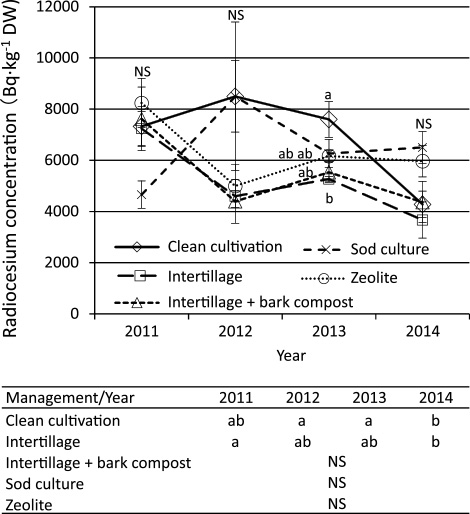
Changes in radiocesium concentration in soils of 0–5 cm depth. Values are the mean (134Cs + 137Cs) ± SE (n = 3). Different letters indicate significance at the 5% level by the Tukey-Kramer test. In the figure, different letters indicate significant differences among experimental plots in each year, while in the table, different letters indicate significant differences among years in each experimental plot.
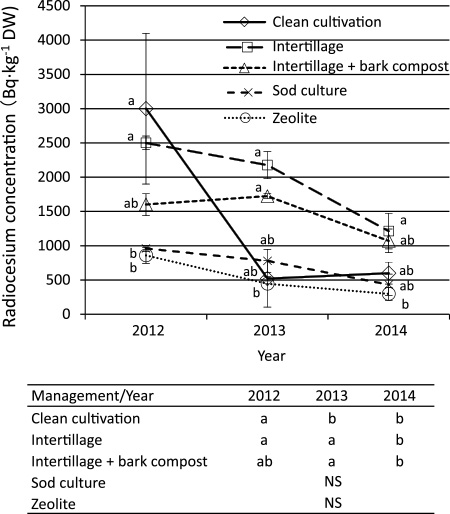
Changes in radiocesium concentration in soils of 5–15 cm depth. Values are the mean (134Cs + 137Cs) ± SE (n = 3). Different letters indicate significance at the 5% level by the Tukey-Kramer test. In the figure, different letters indicate significant differences among experimental plots in each year, while in the table, different letters indicate significant differences among years in each experimental plot.
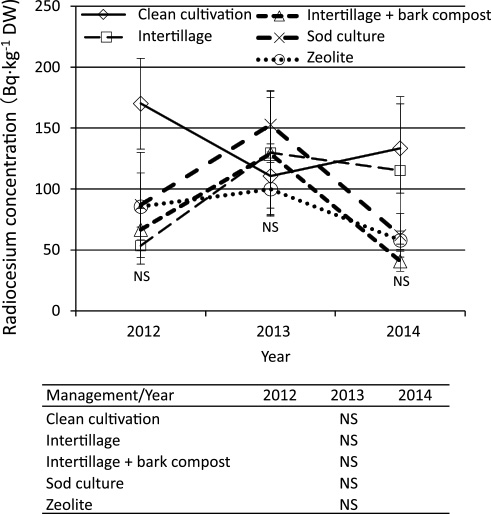
Changes in radiocesium concentration in soils of 15–30 cm depth. Values are mean (134Cs + 137Cs) ± SE (n = 3). Different letters indicate significance at the 5% level by the Tukey-Kramer test. In the figure, different letters indicate significant differences among experimental plots in each year, while in the table, different letters indicate significant differences among years in each experimental plot.
The radiocesium amount in the organic matter on the soil surface under a canopy varied with the type of soil surface management used (Fig. 4). In 2011, the amount of radiocesium in organic matter on the surface of soil managed with sod culture was the highest, followed by that in organic matter on soil managed with clean cultivation and zeolite application, whereas the amounts of radiocesium in organic matter on soil managed with intertillage were significantly lower than those in organic matter on soil managed using other types of management. This trend was also seen over 3 years. The amount of radiocesium in the organic matter of soil managed with sod culture, clean cultivation, and zeolite application decreased greatly from 2011 to 2012, but the decrease was not significant in clean cultivation, with significant year-to-year differences observed for the sod culture, zeolite application, and intertillage + bark compost treatments. The ratios of the amount of radiocesium in organic matter on soil to that in the soil layers (0–15 cm depth) were determined (Table 1). In 2011, the ratio in sod culture was the highest, representing approximately one-third of total radiocesium in the organic matter in 2011. The ratios decreased annually, and were apparently low in experimental plots with intertillage.
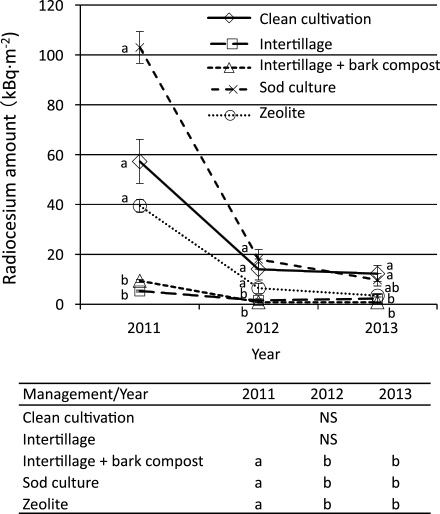
Changes in radiocesium amount in the organic matter on the soil surface under a canopy. Values are the mean (134Cs + 137Cs) ± SE (n = 3). Different letters indicate significance at the 5% level by the Tukey-Kramer test. In the figure, different letters indicate significant differences among experimental plots in each year, while in the table, different letters indicate significant differences among years in each experimental plot.
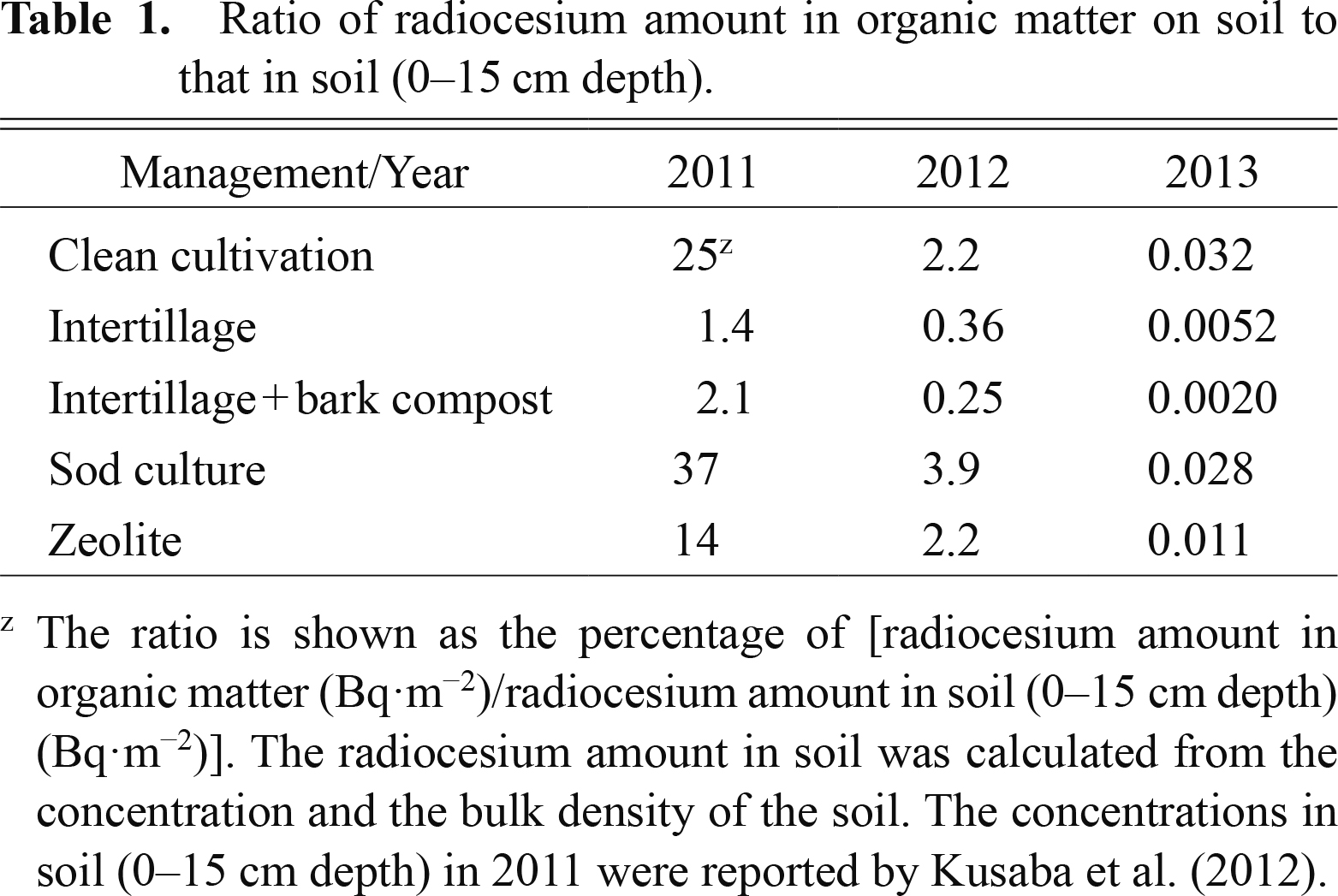
Ratio of radiocesium amount in organic matter on soil to that in soil (0–15 cm depth).
The changes in radiocesium concentrations over 4 years in fruit were determined; the concentrations in fruit decreased significantly and exponentially (the R2 values of the clean cultivation approximation formula were 0.96 as calculated by exponential approximation, and 0.71 as calculated by straight-line approximation) over 4 years in each soil surface management type, with a similar decreasing trend noted for all management types (Fig. 5). The radiocesium concentrations in fruit were not significantly different except in 2013, where they were the highest in soil amended with zeolite, and the lowest in that managed with intertillage + bark compost. For all management types, a correlation between the radiocesium concentration in fruit and the annual variation in the radiocesium concentration in soil managed using the different techniques could not be determined.
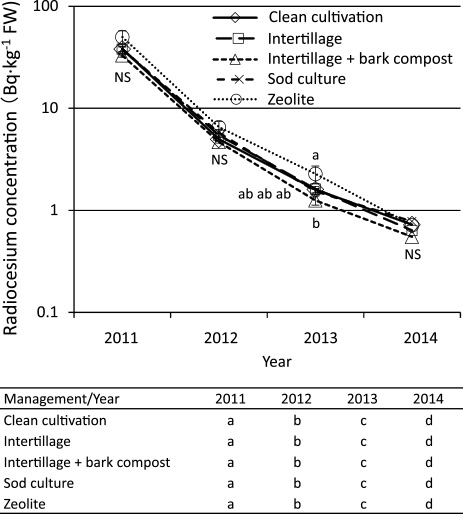
Changes in radiocesium concentration in fruit of apple trees grown on soil managed using different types of soil surface management. Values are the mean (134Cs + 137Cs) ± SE (n = 3). Different letters indicate significance at the 5% level by the Tukey-Kramer test. In the figure, different letters indicate significant differences among experimental plots in each year, while in the table, different letters indicate significant differences among years in each experimental plot.
The radiocesium concentrations in the surface- (0–5 cm) and mid-layer (5–15 cm) soil varied according to the different types of soil surface management. With regard to the surface soil (0–5 cm), only the soil managed with sod culture had an elevated concentration of radiocesium from 2011 to 2014 (Fig. 1). Furthermore, the radiocesium amount in organic matter on the soil surface under the canopy managed with sod culture was the highest among each treatment in 2011, and considerably decreased in 2012 (Fig. 4), and the ratio of the amount of radiocesium in the organic matter to that in the soil (0–15 cm depth) was 37% (Table 1). These results observed in sod culture suggest that much of the fallen radiocesium might adhere to the weeds on the soil surface, which possibly interrupted the accumulation of radiocesium in the soil surface in 2011. This might also be true for the clean cultivation and zeolite plots. Moreover, the results suggest that, in subsequent years, the concentration of radiocesium increased with radiocesium leached from withering weeds to the surface soil.
However, in the subsequent years, soil in intertillage showed higher radiocesium concentrations in the mid-layer of soil than the radiocesium concentrations in soil managed with sod culture and zeolite application (Fig. 2). Arapis et al. (1997) and Sato (2014) demonstrated that the majority of the residual radiocesium was near the soil surface in undisturbed soil. Hence, the intertillage of the soil surface might move the radiocesium downward from the soil surface. Furthermore, intertillage of the soil surface was accompanied by the plowing of the radiocesium attached on the organic matter into the soil (Fig. 4; Table 1). Consequently, the amount of radiocesium in the organic matter in the experimental plots subjected to intertillage was lower than in other experimental plots, and the radiocesium concentrations in the mid-layer (5–15 cm depth) soil managed with intertillage was possibly high in the year following the FDNPP accident. The effect of bark compost application with intertillage on the radiocesium concentration in soil was not significantly different from that obtained with intertillage only (Figs. 1–3).
The radiocesium concentrations in the soil and the amounts in organic matter on the soil surface were not significant for the three types of soil managed without intertillage, except for those managed with clean cultivation (5–15 cm depth in 2012, and 0–5 cm depth in 2013). Additionally, zeolite application did not affect the concentration and the amount of radiocesium among the three management types without intertillage (Figs. 1–4). The annual variation in the radiocesium concentration of the soil managed with clean cultivation was greater than that in other soil surface management types. However, the underlying reason for this is not clear, although it is possible that the radiocesium from the windbreak trees (Japanese cypress of about 3 m in height) that were adjacent to the apple trees in clean cultivation (located about 2 m from the windbreak) might have had an effect on the concentrations in soil managed with clean cultivation, as they could receive dropping water and/or fallen leaves from the windbreak.
Tsuchiya et al. (1976) demonstrated that 68.3% of the roots of the 10-year-old cultivar ‘Jonathan’ on M26 rootstock were distributed in the 0–30 cm soil layer, and most of the fine roots existed in the 0–30 cm layer. Although the apple trees studied herein were 17-year-old cultivar ‘Fuji’ on M26 rootstock, the trend of root distribution could be similar to that reported by Tsuchiya et al. (1976) with some additional root growth with aging. The annual decrease of the radiocesium concentration in apple fruit obtained from each soil surface management type showed a similar trend (Fig. 5), despite the variation in the concentration in each soil layer according to the soil surface management type and the fact that the main root of apple trees was distributed in the 0–30 cm soil layer. These results suggest that the apple fruit were not affected by the changes in the concentration of radiocesium in the rooting zone in the soil analyzed in this study. This idea can be supported by previous reports as follows. Antonopoulos-Domis et al. (1991) demonstrated that the root uptake of radiocesium provided a small fraction of the total contamination of leaves and fruit of trees planted before the Chernobyl accident up to at least 5 years after the accident. Sato (2014) reported that over 95% of the radiocesium was in the aboveground part, and only a small percentage was located underground in apple, peach, and persimmon trees. Furthermore, he suggested that the radiocesium accumulated in the aboveground part of the fruit trees might be due to the translocation of radiocesium from the bark of fruit trees, similar to that observed in Japanese chestnut trees and blueberry bushes (Kusaba et al., 2015a, b). In addition, in 2011, we analyzed other aboveground parts of the apple trees in each experimental plot, including the leaves, current shoots, 2-year-old branches, and 3-year-old branches. During 2011, fallout-derived radiocesium might have adhered directly to the 2-year-old and 3-year-old branches (Kusaba et al., 2012). The radiocesium concentrations of each aboveground part were not significantly different among experimental plots, but the highest concentrations were found in the 2-year-old and 3-year-old branches.
However, Antonopoulos-Domis et al. (1996) reported that the radiocesium that had accumulated in deciduous fruit trees 5 years after the Chernobyl accident was mainly taken up via the roots. In light of these findings, our results should be verified by further research because our study was conducted over 4 years after the FDNPP accident.
The reliable transfer factor (TF) of vegetables, in which intertillage of plow layer soil is necessary in the cultivation, was determined by the Ministry of Agriculture, Forestry and Fisheries (2011; http://www.maff.go.jp/j/press/syouan/nouan/110527.html, May 28, 2015) using a literature search. The TFs of herbaceous fruit were 0.0068 in cucumber, 0.00041 in melon, and 0.00070 in tomato. In this study, the TFs, calculated using the radiocesium concentrations of the fruit and soil (0–15 cm) in the intertillage plots, were 0.013 in 2011, 0.0017 in 2012, 0.00050 in 2013, and 0.00031 in 2014. In the early years of 2011–2014, the TFs in apples may have been affected by the direct adhesion of fallout-derived radiocesium (Kusaba et al., 2015a, b; Sato, 2014; Sato et al., 2015); however, direct radiocesium adhesion might have had a smaller effect on the TF value in 2014. In 2014, the TF values of apples in this study are almost the same as those observed in herbaceous fruit. Thus, even when comparing apple trees and herbaceous fruit, intertillage should have a negligible effect on the accumulation of radiocesium in apples.
Green et al. (1997) reported that, for apple trees grown on peat soils, characterized by high organic matter content, the uptake of cesium from soil to fruit was higher than for trees grown on loamy, sandy, and field site soils. Despite this report, in our case, the bark compost application with intertillage did not increase the concentration of radiocesium in the fruit (Fig. 5). In this study, bark compost was applied at 10 t·ha−1 for 3 years based on conventional practice. It is possible that the amount of bark compost applied in this study had no effect on the absorption of radiocesium via the roots of the apple trees.
The results presented in this study and those in previous reports (Antonopoulos-Domis et al., 1991; Kusaba et al., 2015a, b; Sato, 2014) collectively suggest that the soil surface management type affecting the radiocesium distribution in the soil or the compost applied by the conventional practice have not affected the radiocesium concentration in apple fruit for at least 4 years from the time of the FDNPP accident, at a radiocesium deposition level similar to that in Fukushima City.
We thank Prof. Kunihisa Morinaga (Okayama University), Dr. Yuriko Kano-Murakami [National Agricultural and Food Research Organization (NARO)], and Dr. Hideo Bessho (NARO Institute of Fruit Tree Science) for their helpful advice and technical assistance.